In this second example we’re going to sell a call option live on Tastyworks. As with the first example in the previous lecture, we will then look at what our potential profit will be at expiration, taking into account the premium we collect and the strike price. We will then let the option expire. Once the option has expired we will analyse how the position performed and calculate how much profit/loss was made.
We will use the SLV silver ETF again so it’s a similar trade in most respects, but this time we are going to be the seller of the call option.
First let’s take a quick look at the current price of SLV on a chart I’ve pulled from Trading View.
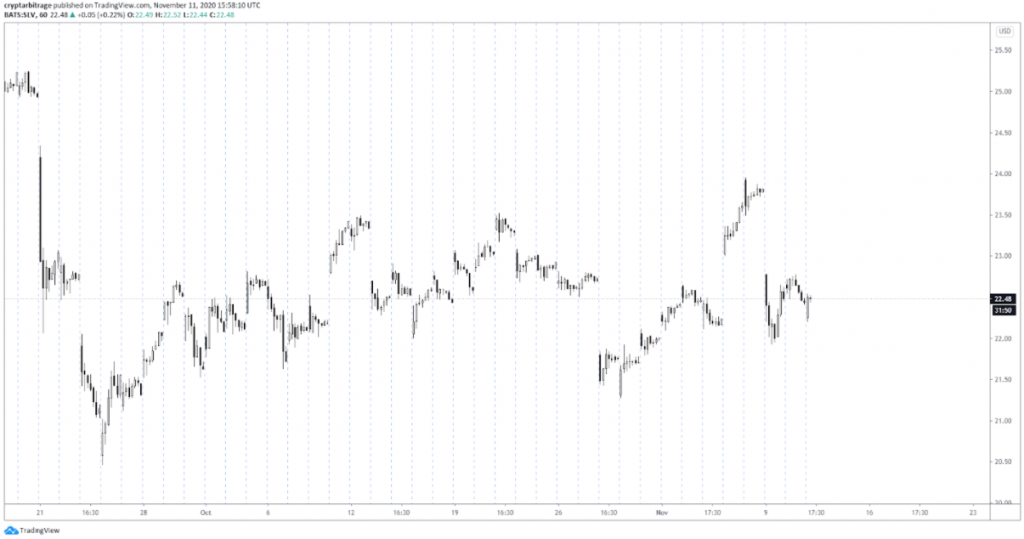
Today is Wednesday 11th November 2020, and SLV is currently trading at around $22.48. This is a one hour chart of the price of SLV, meaning each candle represents one hour. You may recognise part of the chart from the previous example as that was only 2 weeks ago.
This time, let’s say we have a view that the price of SLV is going to stall here. That is, we think it’s going to remain under $23 by the end of the week (which is in 2 days). To capitalise on this we want to sell a call option. We’re going to sell the call option that expires on Friday (which is November 13th), with a strike price of $23. Let’s head over to the tastyworks software to check out the prices and place the trade.
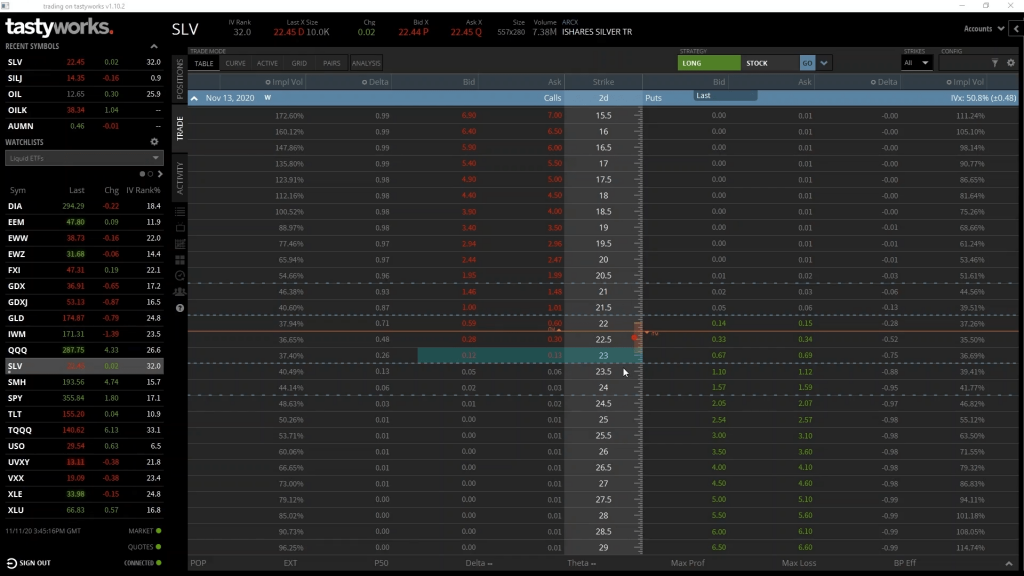
Here we have the option chain for SLV. As you can see in the top left here, I’ve expanded the November 13th expiry date, so every option on the screen here expires on Friday.
We’re interested in the $23 strike price, which we can find in the middle column. And we want the call, so we head left from here.
You should remember from last time, the bid is what we could currently sell this option for immediately, which is 12 cents in this case. The ask is what we could currently buy this option for immediately, which is 13 cents in this case. As we are selling this call today, it’s the bid price that we are interested in.
To populate the order form with an order to sell the call, we can click on the bid price of 12 cents.

As you can see, by clicking the bid price for this option, it’s populated the form with the call option details on the left. This time the number of contracts is a negative number, because we are shorting. Nov 13 is the expiry date, 2d is the number of days until the option expires, 23 is the strike price, C denotes a call, and STO in red denotes that it’s a sell order.
Next, the limit price for the order is the bid price of 12 cents that we just clicked on. As in the previous example, today I’ll just be selling into the bid which we know will fill immediately, meaning we don’t need to adjust any of the other settings.
I’ll click REVIEW & SEND in the bottom right, which will bring up the confirmation screen. This displays all the details of the order we just entered, including any additional trading fees that we will need to pay.

One difference to note, is that when we purchased a call, the amount of capital we needed to use was limited to the premium plus fees. Now that we are selling a call though, the amount of capital that will be tied up by this position is dramatically higher than this. This is the margin that we discussed in lecture 3.6. As the potential loss of selling this call option is undefined, we are required to hold some extra funds in our account to support the position, in case it goes against us.
Once we click SEND ORDER, the order is sent into the market. Because we are selling straight into the current bid price of 12 cents, this order filled immediately. The pop ups show first that the order was working in the market, and then immediately that it was filled.
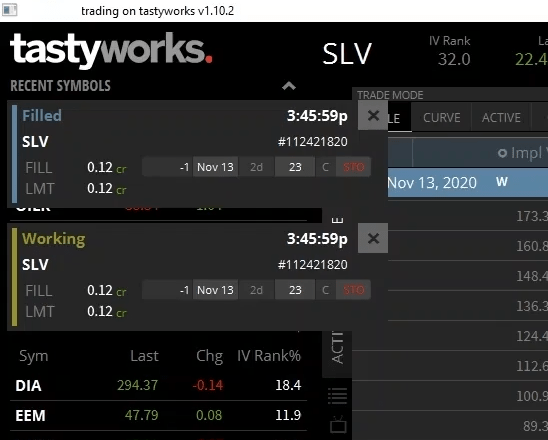
This option will expire in 2 days. Before skipping ahead to see what happened, let’s look at what could happen with this position depending on what happens to the price of SLV in the next two days. We can use the other section 3 lectures to calculate our potential profit, potential loss, and where the breakeven point on this trade is.
What could happen
Let’s remind ourselves of the option parameters we have for this position:
- The underlying asset is shares of SLV
- The option type is call
- The expiry date is 13th November 2020
- The strike price is $23
- The option price (or premium) is $0.12 per share
As this is a real world example we will also include the fees in our calculations.
The total fees and commission for our order were $1.15. As the contract multiplier for SLV is 100, each option contract represents 100 shares of SLV. We sold 1 contract, representing 100 shares, so this total fee of $1.15 equates to a fee per share of $0.0115, or a little over 1 cent. This per share amount will help us in some of our calculations.
PNL chart
Given all the parameters we just covered, this is the PNL chart at expiry for this option position.
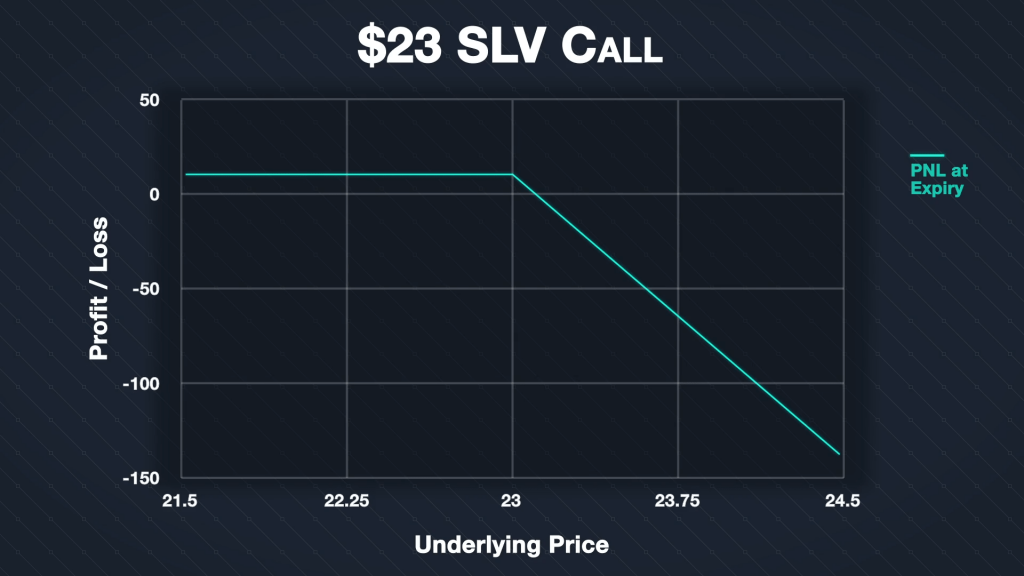
For any price of SLV below the strike price of $23, we will make the maximum possible profit for our short call. This maximum profit is limited to the premium we collected, minus the fees. We collected a premium of $0.12 per share, and the fees were $0.0115 per share. This gives us a total credit per share of $0.1085. As the contract multiplier is 100 and we sold 1 contract, this equates to a total maximum profit of $10.85. And indeed this amount is what was shown as the total credit when we placed the order on tastyworks.
If SLV is any price above our strike price of $23 at expiry, we can calculate our profit or loss using this formula:
(Premium + Strike Price – Price At Expiration) * Contract Multiplier * Number Of Contracts
This is similar to the formula we gave in lecture 3.3, except because we are the seller it has been multiplied by negative one.
Instead of just using the premium collected per share of $0.12, we can use the total collected per share, which includes the fees. So $0.1085 per share.
The profit/loss line decreasing to the right of our strike price is just this same formula plotted for each underlying price of SLV at expiry.
As an example, if the price of SLV at expiration is $24.30, we can calculate our profit as:
(0.1085 + 23 – 24.30) * 100 * 1 = -$119.15
If the price of SLV at expiration is $24.30, the option to purchase SLV at $23 is clearly worth $1.30 per share, for a total of $130 per contract. As we are the seller of this contract this represents a loss for us. As we also collected $10.85 in total for this option, this gives us our total loss of $119.15.
Breakeven
You may remember, the formula for the breakeven point of a call option is:
Breakeven Point = Strike Price + Premium Paid
This calculation is the same for both buyer and seller. As with the profit calculations, instead of using just the premium collected, we will use the total credit including fees, which is $0.1085 per share. The breakeven point is then calculated as:
$23 + $0.1085 = $23.1085
This is the point at which the profit/loss line crosses the x axis. Because we are the seller, any point higher than this will result in a loss, and any point lower than this will result in a profit.
What actually happened
Now we’ve studied what could happen, let’s jump forward and find out what actually did happen. Here we have the same 1 hour price chart of SLV we looked at just before placing the trade. Except now of course, it’s the end of Friday 13th November, so the option has expired.
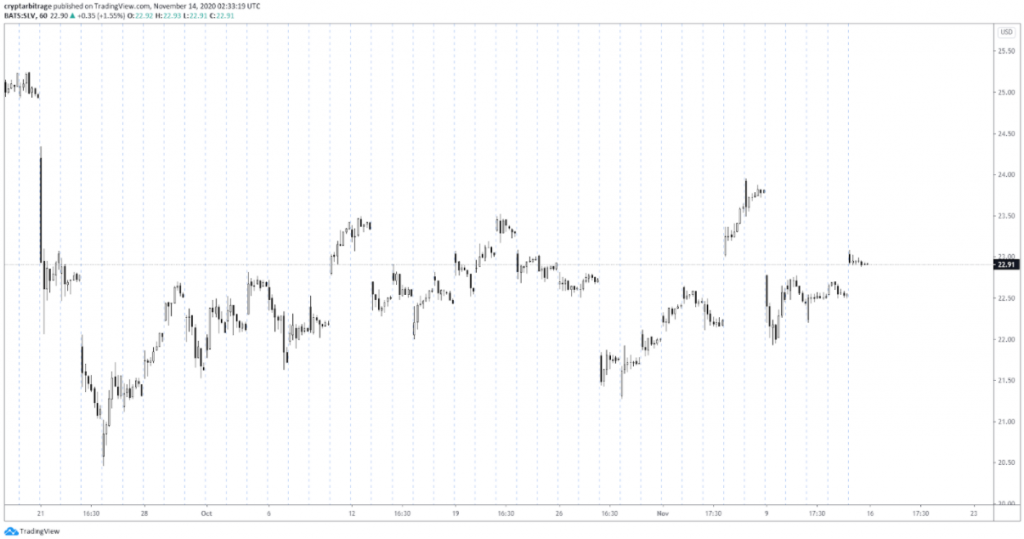
We can see the point in time we bought the call option here 2 days ago on the 11th. At the start of today’s session, the price actually gapped up, and was higher than our strike price of $23 briefly. By the end of the day though, the price of SLV had settled back down to $22.91. This is below the strike price of $23, so the option has expired worthless, resulting in the maximum possible profit for this trade of $10.85.
Despite the fact that the price of SLV actually increased over the course of this trade, it expired below the strike price, so we still made our full profit.
Underlying position comparison
We began with a neutral to bearish bias, so we sold a call option. The price then failed to get above our chosen strike price at expiry. This resulted in a profit, but how does this profit compare to a position in the underlying? In other words, what if we had sold 100 shares of SLV instead?
You may remember the price of SLV was $22.48 when we sold the call, so we could have sold 100 shares for $2,248 instead. At the end of Friday the price had increased to $22.91, meaning we would now have to pay $2,291 to buy back those shares. This means selling the shares themselves would have resulted in a loss of $43 (plus a little extra for fees).
Selling the call option then, worked considerably better than selling the shares would have in this instance. Selling the call made a profit, whereas selling the shares would have made a loss.
To complete this section you must take the quiz below:

